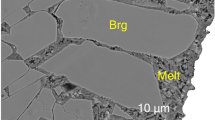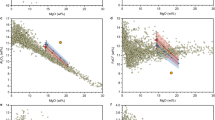Abstract
The melting of peridotite in the mantle wedge above subduction zones is generally believed to involve hydrous fluids derived from the subducting slab1. But if mantle peridotite is upwelling within the wedge, melting due to pressure release could also contribute to magma production. Here we present measurements of the volatile content of primitive magmas from Galunggung volcano in the Indonesian arc which indicate that these magmas were derived from the pressure-release melting of hot mantle peridotite. The samples that we have analysed consist of mafic glass inclusions in high-magnesium basalts. The inclusions contain uniformly low H2O concentrations (0.21–0.38 wt%), yet relatively high levels of CO2 (up to 750 p.p.m.) indicating that the low H2O concentrations are primary and not due to degassing of the magma. Results from previous anhydrous melting experiments on a chemically similar Aleutian basalts2 indicate that the Galunggung high-magnesium basalts were last in equilibrium with peridotite at ∼1,320 °C and 1.2 GPa. These high temperatures at shallow sub-crustal levels (about 300–600 °C hotter than predicted by geodynamic models1,3), combined with the production of nearly H2O-free basaltic melts, provide strong evidence that pressure-release melting due to upwelling in the sub-arc mantle has taken place. Regional low-potassium4 and low-H2O (ref. 5) basalts found in the Cascade arc indicate that such upwelling-induced melting can be widespread.
This is a preview of subscription content, access via your institution
Access options
Subscribe to this journal
Receive 51 print issues and online access
$199.00 per year
only $3.90 per issue
Buy this article
- Purchase on Springer Link
- Instant access to full article PDF
Prices may be subject to local taxes which are calculated during checkout


Similar content being viewed by others
References
Davies, J. H. & Stevenson, D. J. Physical model of source region of subduction zone volcanics. J. Geophys. Res. 97, 2037–2070 (1992).
Draper, D. S. & Johnston, A. D. Anhydrous PT relations of an Aleutian high-MgO basalt: an investigation of the role of olivine-liquid reaction in the generation of arc high-alumina basalts. Contrib. Mineral. Petrol. 112, 501–519 (1992).
Furukawa, Y. Depth of the decoupling plate interface and thermal structure under arcs. J. Geophys. Res. 98, 20005–20013 (1993).
Bacon, C. R.,et al. Primitive magmas at five Cascade volcanic fields: melts from hot, heterogeneoussub-arcmantle.Can. Mineral. 35, 397–423 (1997).
Sisson, T. W. & Layne, G. D. H2O in basalt and basaltic andesite glass inclusions from four subduction-related volcanoes. Earth Planet. Sci. Lett. 117, 619–635 (1993).
Sudradjat, A. & Tilling, R. Volcanic hazards in Indonesia: The 1982–83 eruption of Galunggung. Episodes 7, 13–19 (1984).
Gerbe, M.-C.et al. Mineralogical and geochemical evolution of the 1982–1983 Galunggung eruption (Indonesia). Bull. Volcanol. 54, 284–298 (1992).
Harmon, R. S. & Gerbe, M.-C. The 1982–83 eruption at Galunggung Volcano, Java (Indonesia): Oxygen isotope geochemistry of a chemically zoned magma chamber. J. Petrol. 33, 585–609 (1992).
Sobolev, A. V. & Danushevsky, L. V. Petrology and geochemistry of boninites from the north termination of the Tonga Trench: Constraints on the generation conditions of primary high-Ca boninite magmas. J. Petrol. 35, 1183–1211 (1994).
Sobolev, A. V. & Chaussidon, M. H2O concentrations in primary melts from supra-subduction zones and mid-ocean ridges: Implications for H2O storage and recycling in the mantle. Earth Planet. Sci. 137, 45–55 (1996).
Dixon, J. E. & Stolper, E. M. An experimental study of water and carbon dioxide solubilities in mid-ocean ridge basaltic liquids. Part II: Applications to degassing. J. Petrol. 36, 1633–1646 (1995).
Roggensack, K., Hervig, R. L., McKnight, S. B. & Williams, S. N. Explosive basaltic volcanism from Cerro Negro volcano: influence of volatiles on eruptive style. Science 277, 1639–1642 (1997).
Holloway, J. R. & Blank, J. G. Applications of experimental results to C-O-H species in natural melts. Rev. Mineral. 30, 187–230 (1994).
Dixon, J. E., Clague, D. A. & Stolper, E. M. Degassing history of water, sulfur, and carbon in submarine lavas from Kilauea volcano, Hawaii. J. Geol. 99, 371–394 (1991).
Anderson, A. T. Chlorine, sulfur, and water in magmas and oceans. Geol. Soc. Am. Bull. 85, 1485–1492 (1974).
Anderson, A. T. Parental basalts in subduction zones: Implications for continental evolution. J.Geophys. Res. 87, 7047–7060 (1982).
Michael, P. Regionally distinctive sources of depleted MORB: Evidence from trace elements and H2O. Earth Planet. Sci. Lett. 131, 301–320 (1995).
Bartels, K. S., Kinzler, R. J. & Grove, T. L. High pressure phase relations of primitive high-alumina basalts from Medicine Lake volcano, northern California. Contrib. Mineral. Petrol. 108, 253–270 (1991).
Hasegawa, A., Zhao, D., Hori, S., Yamamoto, A. & Horiuchi, S. Deep structure in the northeast Japan arc and its relationship to seismic and volcanic activity. Nature 352, 683–689 (1991).
Tatsumi, Y., Sakuyama, M., Fukuyama, H. & Kushiro, I. Generation of arc basaltic magmas and thermal structure of the mantle wedge in subduction zones. J. Geophys. Res. 88, 5815–5825 (1983).
Johnston, A. D. & Draper, D. S. Near-liquidus phase relations of an anhydrous high-magnesia basalt from the Aleutian Islands: Implications for arc magma genesis and ascent. J. Volcanol. Geotherm. Res. 52, 27–41 (1992).
Nye, C. J. & Reid, M. R. Geochemistry of primary and least fractionated lavas from Okmok volcano, central Aleutians: Implications for arc magma genesis. J. Geophys. Res. 91, 10271–10287 (1986).
Plank, T. & White, W. W. Nb and Ta in arc and mid-ocean ridge basalts. Eos 76, 655 (1995).
Tormey, D. R., Grove, T. L. & Bryan, W. B. Experimental petrology of normal MORB near the Kane Fracture Zone: 22°–25° N, mid-Atlantic ridge. Contrib. Mineral. Petrol. 96, 121–139 (1987).
Pearce, J. A. in Andesites (ed. Thorpe, R. S.) 525–548 (Wiley, New York, (1982).
Leeman, W. P., Smith, D. R., Hildreth, W., Palacz, Z. & Rodgers, N. Compositional diversity of late Cenozoic basalts in a transect across the southern Washington Cascades: Implications for subduction zone magmatism. J. Geophys. Res. 95, 19561–19582 (1990).
Ihinger, P. D., Hervig, R. L. & McMillan, P. F. Analytical methods for volatiles in glasses. Rev. Mineral. 30, 67–122 (1994).
Acknowledgements
We thank R. Tilling and S. Weaver for samples from Galunggung; J. Lowenstern for instruction in FTIR spectroscopy; G. Layne for performing ion-microprobe analyses; and C. Bacon, M. Clynne, T. Crawford and T. Grove for reviews that helped us to clarify our arguments. This work was supported by the USGS Volcano Hazards Program.
Author information
Authors and Affiliations
Corresponding author
Rights and permissions
About this article
Cite this article
Sisson, T., Bronto, S. Evidence for pressure-release melting beneath magmatic arcs from basalt at Galunggung, Indonesia. Nature 391, 883–886 (1998). https://doi.org/10.1038/36087
Received:
Accepted:
Issue Date:
DOI: https://doi.org/10.1038/36087
This article is cited by
-
Interplay between oceanic subduction and continental collision in building continental crust
Nature Communications (2022)
-
Temporal variations in the diversity of primitive melts supplied to the Santorini silicic magmatic system and links to lithospheric stresses
Contributions to Mineralogy and Petrology (2022)
-
Low-Ca boninite formation by second-stage melting of spinel harzburgite residues at mature subduction zones: new evidence from veined mantle xenoliths from the West Bismarck Arc
Contributions to Mineralogy and Petrology (2018)
-
Shallow-level differentiation of phonolitic lavas from Sumaco Volcano, Ecuador
Contributions to Mineralogy and Petrology (2018)
-
Water in the Earth’s Interior: Distribution and Origin
Space Science Reviews (2017)
Comments
By submitting a comment you agree to abide by our Terms and Community Guidelines. If you find something abusive or that does not comply with our terms or guidelines please flag it as inappropriate.



